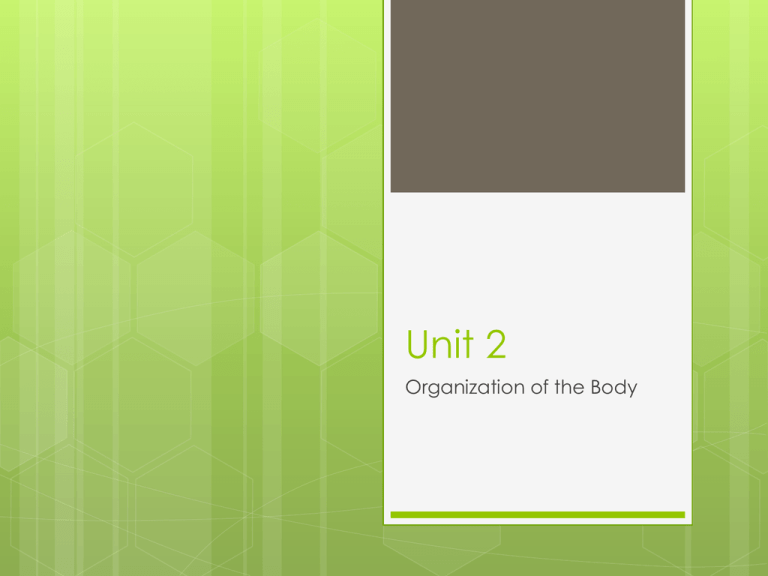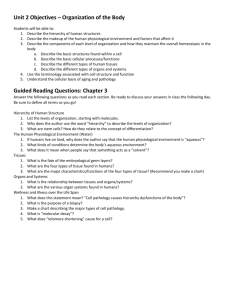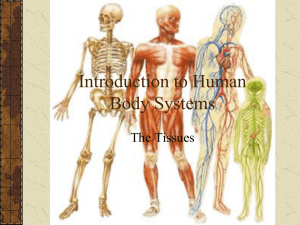Organization of the Body PPT Revised
advertisement

Unit 2 Organization of the Body Hierarchy of Human Structure Guided Reading: 1. List the levels of organization, starting with molecules. 2. What are stem cells? Hierarchy: a series of ordered groupings within a system Alpha male & female Pups & adults Outcasts / Dispersers Levels of Organization Stem Cells Undifferentiated cells have the potential to develop into many different cell types during early life & growth Can be induced to become specialized cells brain cells, red blood cells, skin cells, etc. Embryonic stem cells: derived from fertilized eggs Induced pluripotent stem cells: adult specialized cells that can be “reprogrammed” to become a different kind of cell Blastocyst (early stage of development) stem cells differentiate into specialized cells Adults: stem cells still exist (in organs & bone marrow) to replace old/damaged cells The Human Physiological Environment Guided Reading: 1. If humans live on land, why does the author say that the human physiological environment is “aqueous”? 2. What does it mean when people say that something acts as a “solvent”? The Human Physiological Environment All the internal conditions that allow cells to perform their functions effectively & efficiently. This positively impacts body organization Involves internal & external cellular conditions. Both rely on water. Needs specific conditions to maintain homeostasis: pH, ions, chemical reactions, transport of molecules between internal & external environments Allows us to maintain homeostasis… More on homeostasis Homeostasis ≠ balance. Allows us to adapt to changing environments. Maintained by negative feedback loops Maintain constant conditions inside the body when the external environment fluctuates. “Set point” Often utilizes chemical messengers (e.g. hormones) Negative Feedback Systems Negative Feedback: Maintaining Homeostasis “System” has a set point (ideal level) and “sensors” that detect changes… If it drops below set point, something is produced… If it exceeds that level, production stops… Examples: Thermostat Toilet Body Temperature Example Negative Feedback Loop Generic Example: Gland X releases hormone X… This stimulates target cells to release hormone Y. Eventually, an excess of hormone Y exists Gland X "senses" this… and inhibits its release of hormone X. X X Y Positive Feedback Defined… “Feedback in which the system responds so as to increase the magnitude of any particular perturbation” Results in amplification of the original signal instead of stabilization. Any system where there is a net positive feedback will result in a runaway situation. Requires a feedback loop to operate. Examples: Fruit ripening, childbirth, breastfeeding The Human Physiological Environment The human physiological environment is aqueous. Water is contained in the cells, the blood, body cavities, organ systems, and tissue. Not just sloshing around under the skin!! Water’s atomic structure provides it with all the properties that make it useful for the body. The universal solvent. . . . Water is polar can dissolve most materials needed for human survival Solvent = dissolves other chemicals & forms a solution Solute = a particle that is dissolved in a solvent Water is a good bio solvent b/c it is polar (charged) Most chemical reactions require an aqueous environment Water is a natural solvent for ions, needed for cellular functions Adhesion & cohesion won’t evaporate quickly (so we won’t become easily dehydrated) High specific heat water absorbs much heat energy when it evaporates Living in a balance Dehydration: Diarrhea Sweating Vomiting Indicators: extreme thirst, stop sweating, nausea & exhaustion Water tissues deprived of water intoxication? Body takes in more water than it loses at a given period of time. Upsets natural balance of ions, minerals A Fraternity Hazing Gone Wrong : NPR Tissues Guided Reading: 1. What are the four types of tissue found in humans? 2. What are the major characteristics/functions of the four types of tissue? (Recommend you make a chart) Stem cells again!!!! Retain ability to undergo cell division Assist further body development and healing later in life Stem cells from bone can produce a variety of human tissues Brain stem cells can develop into many types of cells Embryological germ layers Ectoderm skin and brain Mesoderm Bone and muscle Endoderm Digestive organs Lay down the 4 human tissue types into the hierarchy that eventually forms a human Create a Concept Map (aka Mind Map) for One Type of Tissue… How to create a concept map Constructing a concept map Example For each cell type….. Names of cells & structures Characteristics Locations Functions Examples Four Types of Tissues Connective: forms the supportive framework of the organs & body Epithelial: covers internal & external body surfaces; forms layers of cells that line body cavities Muscle: provides body w/ movement & support Nervous: conducts & coordinates body info; highly specialized cells Tissue Type Types of Cells/structures Characteristics of these cells Epithelial Squamous Cuboidal Columnar Flat Cube-shaped; produce secretions Tall, column-shaped; secretions, uptake Simple: Single-layer Stratified: Multi-layered; subject to wear and tear Pseudostratified: False-stratification Connective Matrix Protein: Collagen Protein: Elastin Protein: Reticulum Loose Made of gel, liquid, protein, salts Strength Flexibility Support Most abundant; attachment, stabilization, structure, support Strength, storage, flexibility Dense Muscle Smooth Cardiac Skeletal Nervous Neurons Neuroglia Spindle-shaped; no visible fibers; weak contractions; line organs Heart; visible striations; intercalated disks Large cells; distinct striations; (in)voluntary Motor, Sensory, Interneuron Assist Neuron functions (astrocytes, oligodendites, ependymal cells) Organs, and Systems Guided Reading 1. What is the relationship between tissues and organs/systems? 2. What are the various organ systems found in humans? Organs and Systems Cardiovascular regulates blood flow Digestive regulates nutrition Integumentary provides protection Lymphatic regulates body fluids, helps fight disease Muscular provides structure and movement Skeletal provides support and movement Endocrine regulates body function and development Reproductive regulates sexual function Respiratory regulates atmospheric gasses and certain body wastes Urinary regulates production, storage, and removal of urine Wellness and Illness over the Life Span Guided Reading: 1. What does this statement mean? “Cell pathology causes hierarchy dysfunctions of the body”? 2. What is the purpose of a biopsy? 3. Make a chart describing the major types of cell pathology. 4. What is “molecular decay”? 5. What does “telomere shortening” cause for a cell? Cell Pathology The basis of understanding dysfunction of the body’s hierarchy Dysfunction: Abnormal, impaired, or incomplete functioning of an organism, organ system, organ, tissue or cell. All gross diseases. Cell pathology: examining cells microscopically Biopsy: Removal of diseased cells for study Types of Cell Pathology Prefixes Dys: bad, abnormal A: not Hyper: over, above, exceedingly, in excess Meta: changed; altered Roots Trophy: make to thrive Plasia: formation Stasis: place Cell Pathology Terms Atrophy: or organ. Wasting or decrease in size of a cell, tissue Caused by malnutrition / blood flow problems Lack of muscle use / nerve damage muscle atrophy Dystrophy: “ill growth.” progressive changes in a tissue that is almost always due to long-term malnutrition, decreased blood flow. Muscular dystrophy: general weakening of muscles Hypertrophy: Enlargement of a tissue or organ due to an increase in cell size, NOT CELL NUMBER. Cell Pathology Terms Dysplasia: disorderly growth pattern in a tissue or organ. Hyperplasia: abnormal multiplication in the number of normal cells in a tissue Not cancerous Has significant impact on body structure Increases the risks of certain cancers Distorts the function of the tissue/organ Metaplasia: A change in cell and tissue function from normal to abnormal. Can be reversible Can produce inappropriate functioning of the tissue or organ Cause: DNA damage, exposure to certain chemicals Can lead to cancer or breakdown in cell communication / tissue organization Cell Pathology Terms Metastasis: Diseased cells break away from the original location and establish themselves in new areas of the body Can carry out functions in new location Reserved from cancerous or highly abnormal cells Cell Pathology: Amyloid deposition Amyloid: protein-like material Disagreement: do they cause disease or are they the result of disease? Intended to help but cause harm when build up in cytoplasm Indicators of cell damagecell senses & corrects Cell death is the result usually Cell Pathology: Fatty Change Accumulation of lipids in the cell in response to cellular injury. Excessive alcohol intakeincreased fat in liver cells, disrupting cell function & thus tissue function Cell Pathology: Necrosis Localized tissue death Blood flow decrease (bed sores!) burns, chemical damage, infections, injury Results in diminished functioning of the tissue, organ & organ system. Cellular Aging: Non-mitotic cells Occurs because of accumulated molecular damage Especially in cells that cannot undergo mitosis: fat cells, skeletal muscle, nervous tissue. They can’t fix the damage Fail at tasksaffect tissues, organs, etc. Caused by environmental factors, stress Cells can die early or undergo programmed death protect the nearby cells










